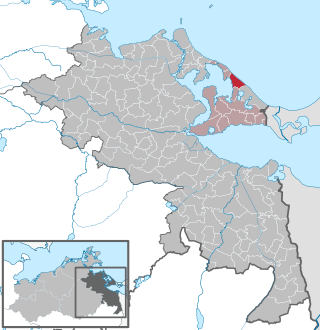
Mecklenburg-Vorpommern, also known by its anglicized name Mecklenburg–Western Pomerania, is a state in the north-east of Germany. Of the country's sixteen states, Mecklenburg-Vorpommern ranks 14th in population; it covers an area of 23,179 km2 (8,949 sq mi), making it the sixth largest German state in area; and it is 16th in population density. Schwerin is the state capital and Rostock is the largest city. Other major cities include Neubrandenburg, Stralsund, Greifswald, Wismar, and Güstrow. It was named after the 2 regions of Mecklenburg and Vorpommern.

Usedom is a Baltic Sea island in Pomerania, divided between Germany and Poland. It is the second largest Pomeranian island after Rügen, and the most populous island in the Baltic Sea.

Zempin is a German municipality and the smallest seaside resort on Usedom island. It lies between Zinnowitz and Koserow on the narrowest part of the island, between the Baltic Sea and the Achterwasser, a bay of the Oder Lagoon.

Karlshagen is a Baltic Sea resort in Western Pomerania in the north of the island Usedom. Karlshagen has 3400 inhabitants and lies between Zinnowitz and Peenemünde.

Trassenheide is a seaside resort on the island of Usedom in the state of Mecklenburg-Vorpommern, in Germany. Trassenheide has approximately 1,000 inhabitants and the main source of income is tourism.

Heringsdorf is a semi-urban municipality and a popular seaside resort on Usedom Island in Western Pomerania, Germany. It is also known by the name Kaiserbad.

Boltenhagen is a German seaside resort in Mecklenburg-Vorpommern situated on the Baltic Sea coast 30 km east of Lübeck. It has a wide view of the Bay of Lübeck; a 5 km stretch of a wide and sandy beach, a boardwalk, restaurants and health spas. Boltenhagen is considered to be part of the German Riviera.

Ueckermünde is a seaport town in northeast Germany, located in the district of Vorpommern-Greifswald, Western Pomerania, near Germany's border with Poland's Police County.

Usedom is a town on Usedom Island, in the Vorpommern-Greifswald district in Mecklenburg-Vorpommern, Germany. It is the seat of the Amt Usedom-Süd, to which 14 other communities also belong.

Binz is the largest seaside resort on the German island of Rügen.

Ahrenshoop is a municipality in the Vorpommern-Rügen district, in Mecklenburg-Vorpommern, Germany on the Fischland-Darß-Zingst peninsula of the Baltic Sea. It used to be a small fishing village, but is today known for its tourism and as a holiday resort.

Ückeritz is a municipality in the Vorpommern-Greifswald district, in Mecklenburg-Vorpommern, Germany.

Pudagla is a municipality in the Vorpommern-Greifswald district, in Mecklenburg-Vorpommern, Germany.

Loddin is a municipality on Usedom Island, in the Vorpommern-Greifswald district, in Mecklenburg-Vorpommern, Germany.

Koserow is a municipality on Usedom Island, in the Vorpommern-Greifswald district, in Mecklenburg-Vorpommern, Germany.

Peenemünde is a municipality on the Baltic Sea island of Usedom in the Vorpommern-Greifswald district in Mecklenburg-Vorpommern, Germany. It is part of the Amt of Usedom-Nord. The community is known for the Peenemünde Army Research Center, where the world's first functional large-scale liquid-propellant rocket, the V-2, was developed.
The Vineta Festival is an annual theatre festival in Germany which began in 1997. The festival takes its name from Vineta, a mythical city said to have been on the southern Baltic Sea located on the island of Usedom. The city is said to have been seen rising from the sea on the beach of Koserow by a young shepherd one Easter morning. A troupe of actors, many of them students at the Theatre Academy of Zinnowitz, participate in the yearly festival.

Resort architecture is an architectural style that is especially characteristic of spas and seaside resorts on the German Baltic coast. The style evolved since the foundation of Heiligendamm in 1793, and flourished especially around the year 1870, when resorts were connected to big cities via railway lines. Until today, many buildings on the German coasts are built in the style or feature distinct elements of resort architecture.

Historical Western Pomerania, also called Cispomerania,Fore Pomerania, Front Pomerania or Hither Pomerania, is the western extremity of the historic region of Pomerania forming the southern coast of the Baltic Sea, Western Pomerania's boundaries have changed through the centuries as it belonged to various countries such as Poland, the Duchy of Pomerania, Sweden, Denmark, as well as Prussia which incorporated it as the Province of Pomerania.

























